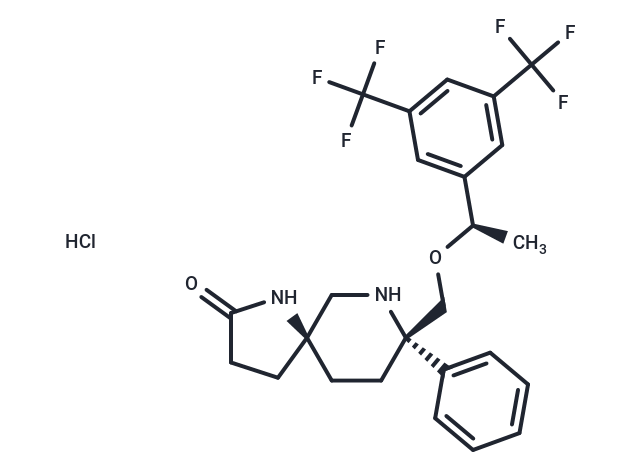Shopping Cart
- Remove All
 Your shopping cart is currently empty
Your shopping cart is currently empty

Rolapitant (SCH619734) hydrochloride is a potent, selective, long-acting, and orally active neurokinin 1 (NK1) receptor antagonist with a K_i of 0.66 nM, which does not interact with CYP3A4 and demonstrates potent centrally-mediated anti-emetic activity in both acute and delayed ferret emesis models [1] [2].

| Pack Size | Price | Availability | Quantity |
|---|---|---|---|
| 1 mg | $155 | In Stock | |
| 5 mg | $385 | In Stock | |
| 10 mg | $548 | In Stock | |
| 25 mg | $822 | In Stock | |
| 50 mg | $1,110 | In Stock | |
| 100 mg | $1,500 | In Stock | |
| 200 mg | $1,980 | In Stock | |
| 1 mL x 10 mM (in DMSO) | $463 | In Stock |
| Description | Rolapitant (SCH619734) hydrochloride is a potent, selective, long-acting, and orally active neurokinin 1 (NK1) receptor antagonist with a K_i of 0.66 nM, which does not interact with CYP3A4 and demonstrates potent centrally-mediated anti-emetic activity in both acute and delayed ferret emesis models [1] [2]. |
| Targets&IC50 | NK1 (gerbil):0.13 (Ki), NK1 (monkey):2.5 (Ki), NK1 (mouse):60.4 (Ki), NK1 (rabbit):31.7 (Ki), rat NK1:78.6 (Ki), NK1 (human):0.66 (Ki), NK1 (guinea pig):0.72 (Ki) |
| In vitro | In vitro studies indicate that rolapitant has a high affinity for the human NK1 receptor of 0.66 nM and high selectivity over the human NK2 and NK3 subtypes of >1000-fold, as well as preferential affinity for human, guinea pig, gerbil and monkey NK1 receptors over rat, mouse and rabbit [1]. Rolapitant (1-1000 nM) inhibits the GR-73632 (an NK1 receptor agonist)-induced calcium efflux with a concentration-dependent and competitive manner in CHO cells expressing the human NK1 receptor [1]. |
| In vivo | Rolapitant, administered orally (0.03-1 mg/kg) or intravenously (0.3-1 mg/kg) as a single dose, effectively mitigates the GR-73632-induced foot-tapping in Mongolian Gerbils and prevents acute emesis triggered by apomorphine and cisplatin in ferrets, with observations lasting up to 72 hours. In the Mongolian Gerbil model, the compound, when given orally, significantly reduces the foot-tapping response, achieving an ID90 at 0.3 mg/kg and maintaining inhibition for over 24 hours. Intravenous administration resulted in a complete cessation of foot-tapping at a dose of 1 mg/kg. In ferrets, rolapitant dose-dependently inhibits vomiting and retching induced by both emetic agents over a 72-hour period, illustrating its potential as an effective clinical antiemetic. This aligns with the ferret emesis model's predictive value for clinical antiemetic efficacy, endorsing rolapitant as a promising candidate for this purpose. |
| Alias | Rolapitant HCl |
| Molecular Weight | 536.94 |
| Formula | C25H27ClF6N2O2 |
| Cas No. | 858102-79-1 |
| Smiles | Cl.C[C@@H](OC[C@]1(CC[C@]2(CCC(=O)N2)CN1)c1ccccc1)c1cc(cc(c1)C(F)(F)F)C(F)(F)F |
| Relative Density. | no data available |
| Storage | Powder: -20°C for 3 years | In solvent: -80°C for 1 year | Shipping with blue ice/Shipping at ambient temperature. | ||||||||||||||||||||||||||||||
| Solubility Information | DMSO: 50 mg/mL (93.12 mM), Sonication is recommended. | ||||||||||||||||||||||||||||||
Solution Preparation Table | |||||||||||||||||||||||||||||||
DMSO
| |||||||||||||||||||||||||||||||

Copyright © 2015-2025 TargetMol Chemicals Inc. All Rights Reserved.